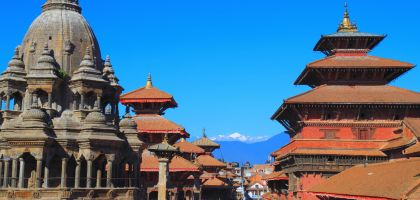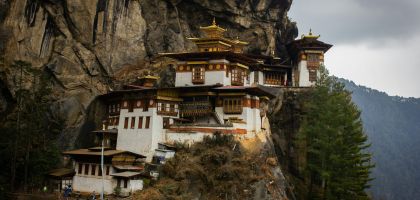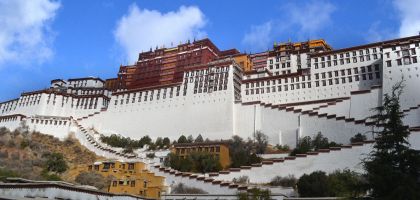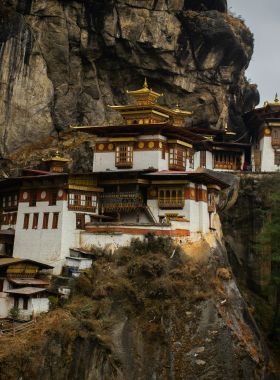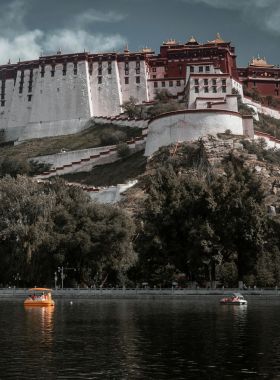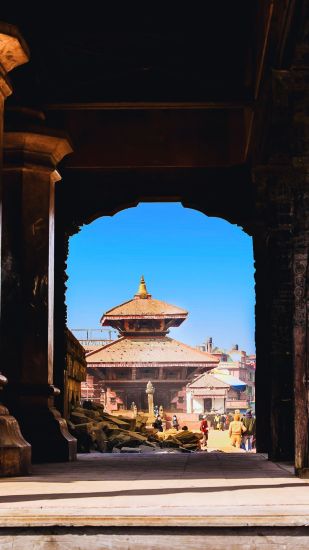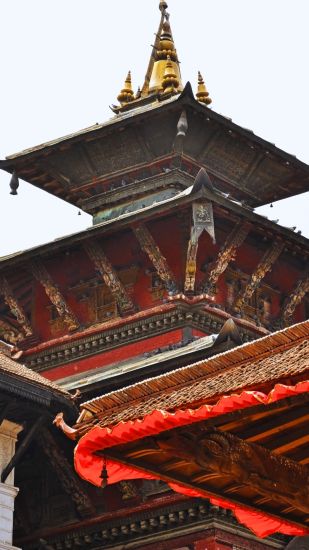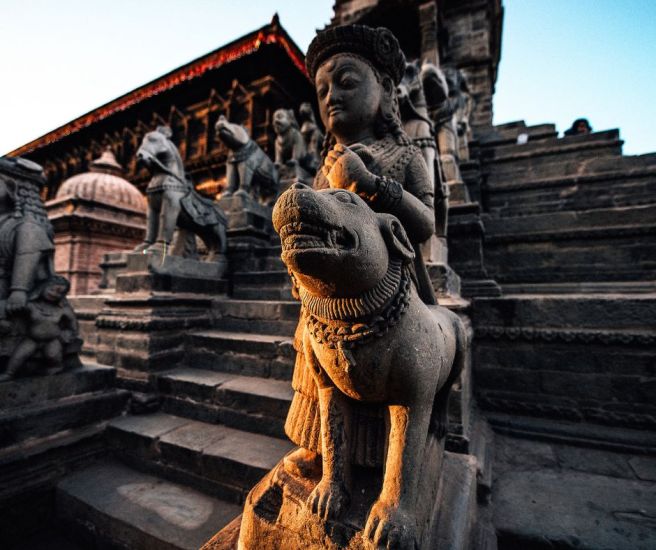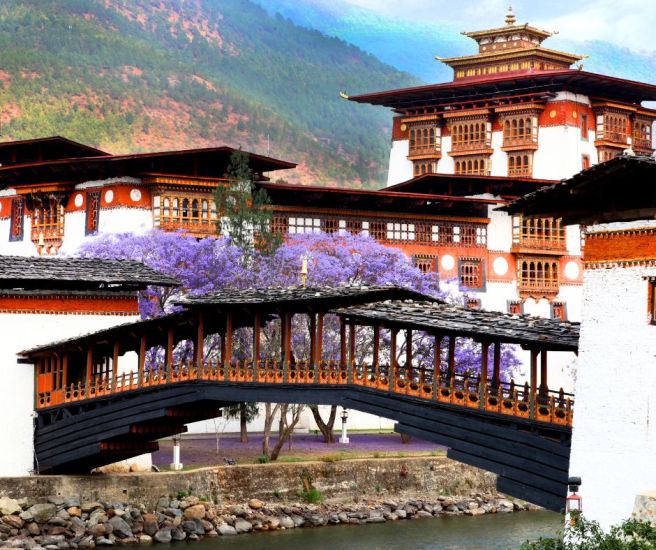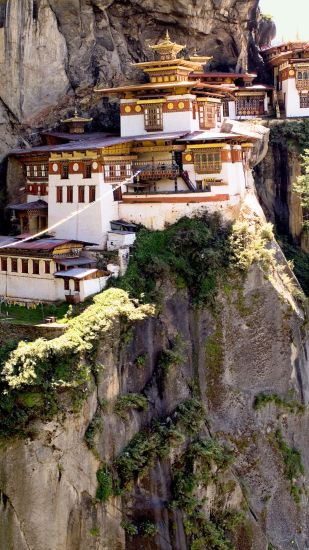Exclusive Nepal Bhutan Tour
11 Days / Cross Border Tours
Activity
Difficulty Level
Destinations
Trip Start / End
Accommodation
Travel Style
Best time to travel
Personalized Travel Advice

Dev Raj Nepal
+977 9851096523
Detailed Itinerary
01
DAY
01
Upon your arrival, you’ll receive a warm welcome and be escorted to your hotel. In the evening, savor an authentic Nepalese dinner at Krishnarpan, the signature restaurant of Dwarika’s Hotel.
Renowned for its slow-dining experience, Krishnarpan offers a culinary journey that celebrates Nepal’s rich traditions and diverse ethnic heritage. Each carefully curated menu is crafted using fresh ingredients from Dwarika’s own organic farms, ensuring a feast for your senses.
Arrival Kathmandu
Upon your arrival, you’ll receive a warm welcome and be escorted to your hotel. In the evening, savor an authentic Nepalese dinner at Krishnarpan, the signature restaurant of Dwarika’s Hotel.
Renowned for its slow-dining experience, Krishnarpan offers a culinary journey that celebrates Nepal’s rich traditions and diverse ethnic heritage. Each carefully curated menu is crafted using fresh ingredients from Dwarika’s own organic farms, ensuring a feast for your senses.
02
DAY
02
Optional: Early in the morning, take 1-hour exhilarating Mountain Flight, offering breathtaking views of the Himalayas, including Mount Everest and other towering peaks.
Note: Several reputed airlines operate these flights, namely, Buddha Air, Yeti Airlines, and Shree Airlines, ensuring safety and comfort. Flights operate early in the morning, typically between 6:00 AM and 9:00 AM, ensuring clear skies and the best visibility.
Begin your journey at Pashupatinath Temple, one of the most revered Hindu temples in the world. Situated along the sacred Bagmati River, this UNESCO World Heritage Site is a place of profound devotion and rituals. Witness the timeless ceremonies performed by priests and devotees, as the air resonates with chants and the fragrance of incense.
Next, visit the iconic Boudhanath Stupa, a symbol of peace and harmony. This massive stupa, crowned with the all-seeing eyes of the Buddha, draws pilgrims and monks from across the globe. Feel the serene energy as you walk alongside devotees circumambulating the stupa, spinning prayer wheels, and offering prayers with butter lamps.
In the afternoon, venture to the medieval city of Bhaktapur, a living museum of ancient Nepali culture and architecture. Known for its well-preserved Newari heritage, Bhaktapur is a UNESCO World Heritage Site that transports you to a bygone era. The city is famous for its intricately carved wooden windows, stunning temples, and atmospheric squares.
Start at Durbar Square, where you can admire the majestic Vatsala Temple, the Lion’s Gate, and the Statue of King Bhupatindra Malla. Stroll through the 55-Window Palace, a stunning piece of architecture, and the Golden Gate, often hailed as one of the most beautiful temple gates in the world. Wander through the narrow, cobbled streets lined with traditional Newar houses, where artisans continue their age-old crafts, shaping pottery, carving wood, and weaving textiles. Visit Pottery Square to see local potters at work, creating handmade pieces using time-honored techniques. You can even try your hand at pottery, an ancient craft passed down through generations.
Kathmandu Exploration
Optional: Early in the morning, take 1-hour exhilarating Mountain Flight, offering breathtaking views of the Himalayas, including Mount Everest and other towering peaks.
Note: Several reputed airlines operate these flights, namely, Buddha Air, Yeti Airlines, and Shree Airlines, ensuring safety and comfort. Flights operate early in the morning, typically between 6:00 AM and 9:00 AM, ensuring clear skies and the best visibility.
Begin your journey at Pashupatinath Temple, one of the most revered Hindu temples in the world. Situated along the sacred Bagmati River, this UNESCO World Heritage Site is a place of profound devotion and rituals. Witness the timeless ceremonies performed by priests and devotees, as the air resonates with chants and the fragrance of incense.
Next, visit the iconic Boudhanath Stupa, a symbol of peace and harmony. This massive stupa, crowned with the all-seeing eyes of the Buddha, draws pilgrims and monks from across the globe. Feel the serene energy as you walk alongside devotees circumambulating the stupa, spinning prayer wheels, and offering prayers with butter lamps.
In the afternoon, venture to the medieval city of Bhaktapur, a living museum of ancient Nepali culture and architecture. Known for its well-preserved Newari heritage, Bhaktapur is a UNESCO World Heritage Site that transports you to a bygone era. The city is famous for its intricately carved wooden windows, stunning temples, and atmospheric squares.
Start at Durbar Square, where you can admire the majestic Vatsala Temple, the Lion’s Gate, and the Statue of King Bhupatindra Malla. Stroll through the 55-Window Palace, a stunning piece of architecture, and the Golden Gate, often hailed as one of the most beautiful temple gates in the world. Wander through the narrow, cobbled streets lined with traditional Newar houses, where artisans continue their age-old crafts, shaping pottery, carving wood, and weaving textiles. Visit Pottery Square to see local potters at work, creating handmade pieces using time-honored techniques. You can even try your hand at pottery, an ancient craft passed down through generations.
03
DAY
03
After breakfast, begin your day at Swayambhunath Stupa, famously known as the Monkey Temple. Perched on a hilltop, this sacred Buddhist site offers sweeping views of the Kathmandu Valley. The stupa, adorned with Buddha’s all-seeing eyes, is surrounded by spinning prayer wheels, fluttering prayer flags, and centuries-old shrines, creating an atmosphere of serenity and devotion.
Next, Kathmandu Durbar Square awaits, a captivating showcase of Nepal’s royal history and architectural grandeur. Walk among ancient courtyards, ornately carved temples, and the home of the Living Goddess, Kumari. Feel the pulse of the city as street vendors, worshippers, and curious travelers converge in this UNESCO-listed square.
In the afternoon, venture to Patan, a city celebrated for its artistic mastery and Newar heritage. Wander through Patan Durbar Square, where the magnificent Krishna Temple, the ancient royal palace, and elegant pagoda-style temples stand as testaments to a glorious past. Step beyond the main square into hidden alleyways, where master artisans keep centuries-old traditions alive, crafting intricate metalwork, delicate woodcarvings, and vibrant Thangka paintings.
Kathmandu Exploration
After breakfast, begin your day at Swayambhunath Stupa, famously known as the Monkey Temple. Perched on a hilltop, this sacred Buddhist site offers sweeping views of the Kathmandu Valley. The stupa, adorned with Buddha’s all-seeing eyes, is surrounded by spinning prayer wheels, fluttering prayer flags, and centuries-old shrines, creating an atmosphere of serenity and devotion.
Next, Kathmandu Durbar Square awaits, a captivating showcase of Nepal’s royal history and architectural grandeur. Walk among ancient courtyards, ornately carved temples, and the home of the Living Goddess, Kumari. Feel the pulse of the city as street vendors, worshippers, and curious travelers converge in this UNESCO-listed square.
In the afternoon, venture to Patan, a city celebrated for its artistic mastery and Newar heritage. Wander through Patan Durbar Square, where the magnificent Krishna Temple, the ancient royal palace, and elegant pagoda-style temples stand as testaments to a glorious past. Step beyond the main square into hidden alleyways, where master artisans keep centuries-old traditions alive, crafting intricate metalwork, delicate woodcarvings, and vibrant Thangka paintings.
04
DAY
04
Board a scenic flight to Bhutan, offering breathtaking views of the Eastern Himalayas, including Mount Everest, Kanchenjunga, and Bhutan’s own sacred peaks like Jomolhari. Upon arrival at Paro International Airport, complete immigration formalities and begin your exploration of the Land of the Thunder Dragon.
On the way to Thimphu, make a stop at Tachogang Lhakhang Bridge, a historic 15th-century iron suspension bridge draped in colorful prayer flags. Built by the revered Nyingma tantric master Tangtong Gyalpo, the bridge is an architectural marvel, showcasing his pioneering work in iron chain bridges across the Himalayas. Walk across this timeless structure and take in the tranquil surroundings, with the rushing Paro River beneath and the picturesque Tachogang Lhakhang monastery perched on a hillside nearby.
From here, continue your scenic drive to Thimphu, Bhutan’s charming capital, where tradition and modernity coexist harmoniously. As you wind through the valley, catch glimpses of terraced fields, traditional farmhouses, and chortens dotting the landscape. Upon arrival, check in at your hotel and take a leisurely evening stroll through Thimphu’s vibrant streets, lined with beautifully painted wooden facades, bustling handicraft shops, and cultural landmarks. Visit the Clock Tower Square, browse through markets filled with local textiles and souvenirs, or simply soak in the city’s relaxed yet lively atmosphere. Overnight in Thimphu.
Kathmandu – Paro & Drive to Thimphu
Board a scenic flight to Bhutan, offering breathtaking views of the Eastern Himalayas, including Mount Everest, Kanchenjunga, and Bhutan’s own sacred peaks like Jomolhari. Upon arrival at Paro International Airport, complete immigration formalities and begin your exploration of the Land of the Thunder Dragon.
On the way to Thimphu, make a stop at Tachogang Lhakhang Bridge, a historic 15th-century iron suspension bridge draped in colorful prayer flags. Built by the revered Nyingma tantric master Tangtong Gyalpo, the bridge is an architectural marvel, showcasing his pioneering work in iron chain bridges across the Himalayas. Walk across this timeless structure and take in the tranquil surroundings, with the rushing Paro River beneath and the picturesque Tachogang Lhakhang monastery perched on a hillside nearby.
From here, continue your scenic drive to Thimphu, Bhutan’s charming capital, where tradition and modernity coexist harmoniously. As you wind through the valley, catch glimpses of terraced fields, traditional farmhouses, and chortens dotting the landscape. Upon arrival, check in at your hotel and take a leisurely evening stroll through Thimphu’s vibrant streets, lined with beautifully painted wooden facades, bustling handicraft shops, and cultural landmarks. Visit the Clock Tower Square, browse through markets filled with local textiles and souvenirs, or simply soak in the city’s relaxed yet lively atmosphere. Overnight in Thimphu.
05
DAY
05
Today, in Thimphu, we are going to explore a range of fascinating sites that display Bhutanese culture and heritage. We’ll start our day with a visit to the National Institute for Zorig Chusum, also known as the School of Traditional Arts. Here, you can observe skilled artisans and students practicing the 13 traditional Bhutanese arts and crafts, including painting, wood carving, and sculpture.
Next, we’ll head to the Folk Heritage Museum, a living museum housed in a traditional farmhouse that offers an immersive experience into rural Bhutanese life. The museum’s exhibits include historical tools, household items, and displays that illustrate the traditional way of life in Bhutan.
Next, visit the National Institute of Traditional Medicine, dedicated to integrating allopathic and traditional healing practices. This facility includes a large laboratory and production area that ensures the quality of medicinal components, including plants, minerals, and precious metals. They also cultivate various herbs and plants on-site for their Bhutanese medicines.
Make a stop by the Bhutan Postal Museum, established in November 2015 to commemorate the 60th Birth Anniversary of His Majesty the Fourth Druk Gyalpo Jigme Singye Wangchuck. This museum narrates the story of Bhutan’s progress and development through the evolution of its communications and postal systems.
Finally, we’ll visit the Changangkha Lhakhang, one of the oldest temples in Thimphu, known for its historical significance and beautiful architecture. Overnight in Thimphu.
Thimphu Exploration
Today, in Thimphu, we are going to explore a range of fascinating sites that display Bhutanese culture and heritage. We’ll start our day with a visit to the National Institute for Zorig Chusum, also known as the School of Traditional Arts. Here, you can observe skilled artisans and students practicing the 13 traditional Bhutanese arts and crafts, including painting, wood carving, and sculpture.
Next, we’ll head to the Folk Heritage Museum, a living museum housed in a traditional farmhouse that offers an immersive experience into rural Bhutanese life. The museum’s exhibits include historical tools, household items, and displays that illustrate the traditional way of life in Bhutan.
Next, visit the National Institute of Traditional Medicine, dedicated to integrating allopathic and traditional healing practices. This facility includes a large laboratory and production area that ensures the quality of medicinal components, including plants, minerals, and precious metals. They also cultivate various herbs and plants on-site for their Bhutanese medicines.
Make a stop by the Bhutan Postal Museum, established in November 2015 to commemorate the 60th Birth Anniversary of His Majesty the Fourth Druk Gyalpo Jigme Singye Wangchuck. This museum narrates the story of Bhutan’s progress and development through the evolution of its communications and postal systems.
Finally, we’ll visit the Changangkha Lhakhang, one of the oldest temples in Thimphu, known for its historical significance and beautiful architecture. Overnight in Thimphu.
06
DAY
06
We will begin our day by exploring Tashichho Dzong, the majestic fortress-monastery that serves as both a government building and a central monastic seat. Its striking traditional architecture and beautifully landscaped grounds offer a serene start to the day. From there, head to the Memorial Chorten, an iconic stupa dedicated to the 3rd King of Bhutan, Jigme Dorje Wangchuck.
Following that, we will take a scenic drive to Punakha which takes approximately 3 to 4 hours. Our route will take us over the Dochula Pass, situated at 3,100 meters (10,200 feet). At this pass, we’ll stop to enjoy panoramic views of the snow-capped Himalayas and the surrounding valleys, provided the weather is clear.
The journey takes us through charming villages and terraced fields, offering glimpses into rural Bhutanese life. We will also visit the Royal Botanical Park at Lamperi, known for its rich collection of flora and beautiful landscape. Overnight at Punakha.
Thimphu – Punakha
We will begin our day by exploring Tashichho Dzong, the majestic fortress-monastery that serves as both a government building and a central monastic seat. Its striking traditional architecture and beautifully landscaped grounds offer a serene start to the day. From there, head to the Memorial Chorten, an iconic stupa dedicated to the 3rd King of Bhutan, Jigme Dorje Wangchuck.
Following that, we will take a scenic drive to Punakha which takes approximately 3 to 4 hours. Our route will take us over the Dochula Pass, situated at 3,100 meters (10,200 feet). At this pass, we’ll stop to enjoy panoramic views of the snow-capped Himalayas and the surrounding valleys, provided the weather is clear.
The journey takes us through charming villages and terraced fields, offering glimpses into rural Bhutanese life. We will also visit the Royal Botanical Park at Lamperi, known for its rich collection of flora and beautiful landscape. Overnight at Punakha.
07
DAY
07
Today, we immerse ourselves in the enchanting sights and cultural heritage of Punakha. After breakfast, we set out to explore the historical and natural wonders of this picturesque region. Our first stop will be the Punakha Dzong, an architectural masterpiece located at the confluence of the Pho and Mo Chhu rivers. This impressive fortress, built in 1637 by Shabdrung Ngawang Namgyal, is renowned for its stunning design and historical significance. It served as Bhutan’s winter capital and remains a vital administrative and religious center. We’ll take time to explore its grand courtyards, intricate woodwork, and sacred temples.
Following our visit to the dzong, we’ll head to Chimi Lhakhang, also known as the Fertility Temple. This revered site, perched on a hilltop, is dedicated to the Buddhist saint Drukpa Kunley, known as the “Divine Madman.” The temple is famed for its association with fertility and is a popular pilgrimage site for couples seeking blessings for childbirth.
In the afternoon, we take a short 1-hour hike to Khamsum Yulley Namgyal Chorten, a magnificent hilltop monastery built to bring peace and prosperity to Bhutan. The gentle uphill hike winds through rice fields and pine forests, rewarding us with panoramic views of the Punakha Valley from the top. The chorten itself is a remarkable example of Bhutanese architecture and spiritual artistry, making it a perfect conclusion to our day’s exploration.
Punakha Exploration
Today, we immerse ourselves in the enchanting sights and cultural heritage of Punakha. After breakfast, we set out to explore the historical and natural wonders of this picturesque region. Our first stop will be the Punakha Dzong, an architectural masterpiece located at the confluence of the Pho and Mo Chhu rivers. This impressive fortress, built in 1637 by Shabdrung Ngawang Namgyal, is renowned for its stunning design and historical significance. It served as Bhutan’s winter capital and remains a vital administrative and religious center. We’ll take time to explore its grand courtyards, intricate woodwork, and sacred temples.
Following our visit to the dzong, we’ll head to Chimi Lhakhang, also known as the Fertility Temple. This revered site, perched on a hilltop, is dedicated to the Buddhist saint Drukpa Kunley, known as the “Divine Madman.” The temple is famed for its association with fertility and is a popular pilgrimage site for couples seeking blessings for childbirth.
In the afternoon, we take a short 1-hour hike to Khamsum Yulley Namgyal Chorten, a magnificent hilltop monastery built to bring peace and prosperity to Bhutan. The gentle uphill hike winds through rice fields and pine forests, rewarding us with panoramic views of the Punakha Valley from the top. The chorten itself is a remarkable example of Bhutanese architecture and spiritual artistry, making it a perfect conclusion to our day’s exploration.
08
DAY
08
Today, we will take a scenic drive to Paro. In the morning. Upon arrival at Paro, we will begin our tour.
Our first visit will be to the National Museum of Bhutan, housed in the historic Ta Dzong, an ancient watchtower that dates back to 1656. The museum, converted into its present form in 1968, offers an extensive collection of Bhutanese art, including rare bronze statues, paintings, and religious artifacts, all reflecting Bhutan’s rich cultural and spiritual heritage. The museum’s exhibits give a fascinating insight into Bhutanese history, culture, and traditions, making it a must-see for any visitor.
Next, we’ll head to Rinpung Dzong, one of Bhutan’s most iconic landmarks. This stunning fortress-monastery, built in 1646, is perched on a hilltop overlooking the Paro Chu River. Known for its grand architecture and historical significance, Rinpung Dzong serves as the administrative center of the Paro district. We will take time to explore the dzong’s beautiful courtyards, temples, and murals, all of which are intricately decorated with traditional Bhutanese art. This site also holds religious significance and offers panoramic views of the valley below.
Punakha – Paro
Today, we will take a scenic drive to Paro. In the morning. Upon arrival at Paro, we will begin our tour.
Our first visit will be to the National Museum of Bhutan, housed in the historic Ta Dzong, an ancient watchtower that dates back to 1656. The museum, converted into its present form in 1968, offers an extensive collection of Bhutanese art, including rare bronze statues, paintings, and religious artifacts, all reflecting Bhutan’s rich cultural and spiritual heritage. The museum’s exhibits give a fascinating insight into Bhutanese history, culture, and traditions, making it a must-see for any visitor.
Next, we’ll head to Rinpung Dzong, one of Bhutan’s most iconic landmarks. This stunning fortress-monastery, built in 1646, is perched on a hilltop overlooking the Paro Chu River. Known for its grand architecture and historical significance, Rinpung Dzong serves as the administrative center of the Paro district. We will take time to explore the dzong’s beautiful courtyards, temples, and murals, all of which are intricately decorated with traditional Bhutanese art. This site also holds religious significance and offers panoramic views of the valley below.
09
DAY
09
Start the day with an early morning drive to Chele La Pass (3,988m), the highest motorable pass in Bhutan. This scenic excursion offers stunning Himalayan views, including the sacred peak of Jomolhari (7,326m). The journey winds through lush forests of spruce, larch, and rhododendrons, providing a refreshing contrast to the valleys below. At the pass, take in the breathtaking panoramas, walk among colorful prayer flags, or hike to higher viewpoints for an even grander perspective.
After returning to Paro, visit Kyichu Lhakhang, one of Bhutan’s oldest and most sacred temples, dating back to the 7th century. Built to subdue a demoness, this serene site is adorned with ancient murals, intricately carved prayer wheels, and a sacred orange tree believed to bear fruit year-round.
In the evening, enjoy a leisurely stroll through Paro’s charming streets, explore handicraft shops, sip on butter tea, or simply soak in the valley’s peaceful ambiance.
Paro –Excursion to Chele-La Pass
Start the day with an early morning drive to Chele La Pass (3,988m), the highest motorable pass in Bhutan. This scenic excursion offers stunning Himalayan views, including the sacred peak of Jomolhari (7,326m). The journey winds through lush forests of spruce, larch, and rhododendrons, providing a refreshing contrast to the valleys below. At the pass, take in the breathtaking panoramas, walk among colorful prayer flags, or hike to higher viewpoints for an even grander perspective.
After returning to Paro, visit Kyichu Lhakhang, one of Bhutan’s oldest and most sacred temples, dating back to the 7th century. Built to subdue a demoness, this serene site is adorned with ancient murals, intricately carved prayer wheels, and a sacred orange tree believed to bear fruit year-round.
In the evening, enjoy a leisurely stroll through Paro’s charming streets, explore handicraft shops, sip on butter tea, or simply soak in the valley’s peaceful ambiance.
10
DAY
10
In the morning, drive to Satsam Chorten for a soft hike to Taktsang Monastery. The name Taktsang means “Tiger’s Nest”. The monastery is perched on a rocky ledge with a sheer drop of nearly 800m, overlooking the Paro Valley and the river. It is said that in the second half of the 8th century, Guru Padma Sambhava known as the second Buddha in Bhutan, meditated at the spot where the monastery is situated having alighted there on the back of a flying tigress.
The hike takes about 4 hours back and forth. Once you reach the view point of the monastery you have the option to visit the monastery which takes another hour hike.
In the afternoon, we will add a fun, cultural activity by stopping at a local archery range to try your hand at Bhutan’s national sport. Archery is not only a recreational pastime but also an important part of Bhutanese culture and tradition.
Optional: To relax after the hike, you have the option to enjoy a traditional hot stone bath in the evening. This age-old Bhutanese practice offers a soothing experience, with hot stones placed in wooden tubs filled with water and herbs—perfect for unwinding after an adventurous day.
Paro Exploration
In the morning, drive to Satsam Chorten for a soft hike to Taktsang Monastery. The name Taktsang means “Tiger’s Nest”. The monastery is perched on a rocky ledge with a sheer drop of nearly 800m, overlooking the Paro Valley and the river. It is said that in the second half of the 8th century, Guru Padma Sambhava known as the second Buddha in Bhutan, meditated at the spot where the monastery is situated having alighted there on the back of a flying tigress.
The hike takes about 4 hours back and forth. Once you reach the view point of the monastery you have the option to visit the monastery which takes another hour hike.
In the afternoon, we will add a fun, cultural activity by stopping at a local archery range to try your hand at Bhutan’s national sport. Archery is not only a recreational pastime but also an important part of Bhutanese culture and tradition.
Optional: To relax after the hike, you have the option to enjoy a traditional hot stone bath in the evening. This age-old Bhutanese practice offers a soothing experience, with hot stones placed in wooden tubs filled with water and herbs—perfect for unwinding after an adventurous day.
11
DAY
11
Service ends today. After breakfast, you will be transferred to the airport for your depature.
Departure
Service ends today. After breakfast, you will be transferred to the airport for your depature.
Includes / Excludes
Inclusions
-
All Accommodations
-
Daily breakfast in the hotels in Kathmandu.
-
All meals in Bhutan
-
All ground transfers and sightseeing by a private vehicles
-
Knowledgeable Local Guides
-
Sightseeing admission fees
Exclusions
-
Meals other than indicated.
-
Expenses of personal nature such as drinks, tipping, laundry, phone etc.
-
Nepal and Bhutan visa fee
-
Airport tax air fares
-
International Airfare
Trip Info
Spring (March to May)
Spring brings mild temperatures and clear skies, making it an ideal time for sightseeing and outdoor activities. In Nepal, temperatures typically range from 16°C to 25°C, while in Bhutan they hover between 12°C and 22°C, depending on altitude. The weather is pleasant with blooming flowers and lush landscapes. This season is perfect for exploring high-altitude areas, enjoying vibrant festivals, and taking in the breathtaking natural beauty.
Autumn (September to November)
Autumn offers crisp air, stable weather conditions, and excellent visibility, making it another great time for travel. Temperatures are comfortable, around 15°C to 24°C in Nepal and 10°C to 20°C in Bhutan, with cooler evenings in the mountains. The landscape is often adorned with rich autumn colors, and the season is particularly good for trekking and sightseeing, with clear views of the Himalayas and other scenic spots. Weather patterns are generally stable, reducing the risk of travel disruptions.
For your comfort and convenience, all transfers throughout the tour are conducted in well-maintained private vehicles tailored to your group size. Solo travelers and couples are provided with comfortable private sedans or spacious SUVs, ensuring a smooth and enjoyable ride across Nepal and Bhutan’s diverse landscapes. For groups of three or more, we provide a comfortable mini-bus, allowing everyone to travel together with ample space.
Whether you’re journeying through bustling city streets, winding mountain roads, or scenic valleys, our vehicles are equipped to handle all terrains with ease. Each transfer comes with air conditioning, generous luggage space, and a courteous driver, making long drives between destinations relaxing and hassle-free. From historical sites to cultural landmarks and breathtaking natural vistas, you can expect a safe, comfortable, and seamless travel experience throughout your journey.
Our carefully selected accommodations throughout the tour offer the perfect balance of comfort and authenticity, ensuring you feel at home while exploring Nepal and Bhutan. From charming heritage hotels that capture the essence of the local culture to boutique hotels with contemporary amenities, each place reflects the rich history and warm hospitality of the region. Expect cozy rooms with comfortable furnishings, clean facilities, and beautiful views that connect you to the surroundings. After a day of exploration, unwind in peaceful settings that provide a restful retreat. With a focus on comfort, service, and authenticity, your accommodations are a welcoming sanctuary that enhances the overall travel experience.
The food on this tour is a delightful blend of local flavors and international options, ensuring there’s something for every palate. You’ll have the opportunity to savor traditional Nepali and Bhutanese cuisine, including dishes like dal bhat, momo, and ema datshi, each bursting with vibrant spices and fresh ingredients that reflect the region’s rich cultural heritage.
For the unfamiliar palate, Western food is readily available at most hotels and restaurants throughout the journey. From classic pasta and pizzas to sandwiches and salads, you’ll find a variety of Western options to satisfy your cravings.
Spiritual and Cultural Sites
You’ll visit some of the most iconic spiritual landmarks in both Nepal and Bhutan. In Nepal, explore Pashupatinath, a sacred Hindu temple complex, and Boudhanath, one of the largest Buddhist stupas in the world, both offering moments of deep reflection and spiritual connection. Swayambhunath, known as the Monkey Temple, provides not only spiritual solace but also stunning views of Kathmandu Valley. In Bhutan, Rinpung Dzong stands as a symbol of the country’s rich spiritual history, while the Tachogang Lhakhang Bridge offers a peaceful retreat. Each site is a window into the soul of the region’s religious traditions.
Rich Traditions and Local Culture
The heart of your journey lies in the unique traditions and culture of Nepal and Bhutan. You’ll witness Bhutanese craftsmanship at Zorig Chusum, where students learn the country’s 13 traditional arts. In Nepal, you’ll experience the lively culture of the Kathmandu Valley, with its vibrant festivals and age-old customs. The historic Bhaktapur Durbar Square and Kathmandu Durbar Square offer a deep dive into the daily life and rituals of the local people, while Patan immerses you in the artistry of Newar architecture, reflecting the rich history of the valley.
Scenic Views and Picturesque Landscapes
Both countries offer some of the most breathtaking landscapes in the world. As you travel through Nepal and Bhutan, expect sweeping views of snow-capped peaks, rolling hills, and lush valleys. On your journey, the scenic drives will take you through dense forests, past rivers, and high mountain passes, providing stunning backdrops to your spiritual and cultural explorations. Whether it’s the majestic Himalayas on the horizon or the lush green valleys below, the views will stay with you long after the trip ends.
Historical and Architectural Wonders
Nepal and Bhutan boast a rich history reflected in their architectural gems. From the historic palaces and temples of Kathmandu Durbar Square to the towering Rinpung Dzong in Bhutan, the monuments you visit will tell the story of ancient civilizations. Patan Durbar Square offers an intricate look at the city’s rich history and artistic prowess. The National Museum in Paro offers fascinating insights into Bhutan’s heritage, allowing you to learn more about the people, their culture, and their deep connection to the land.
Soft Hikes and Nature Walks
While exploring these destinations, you’ll also have the opportunity to enjoy soft hikes that lead you to scenic viewpoints and quiet monasteries. Whether it’s the peaceful walk to Swayambhunath or a gentle hike up to the Tiger’s Nest temple in Bhutan, these experiences will allow you to connect with nature and the local environment. Expect to walk through serene landscapes, breathing in the crisp air and soaking up the natural beauty that surrounds you.
FAQs
Personalized Travel Advice

Dev Raj Nepal
+977 9851096523
